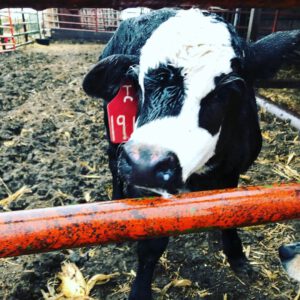Calving season is happening right now across much of the state. If you drive past farmers’ fields, you may see baby calves running around. I must admit, watching the energy and playfulness of calves always brings a smile to my face! Today, I am here to share with you the story behind what goes into bringing those spunky little calves into the world.

It all starts with the cows. When you think about cows, you may have several mental images that come to mind regarding what cows look like. The scientific name for a cow is “bovine,” and bovine are often referred to as “cattle.” There are many types of cattle breeds. On our farm, we have black angus, which is considered a beef animal. A “cow” is actually a mother bovine animal, a heifer is a female bovine that has not had a calf, and a male is a bull. All of the animals on the farm are on very specific diets that help them to consume the proper nutrients they need to be healthy. Our nutritional rations are made by professionals whose jobs are to ensure rations are best suited for the animals on our farm. Normally during the year, we check our cow herd once a day to ensure they are as healthy as possible.
When a storm is coming, it is important to check the cows more frequently, to make sure they are in the proper environment in case they do calf. We have a calving barn, but some people also rely on bales or trees for windbreaks. Windbreaks are important to create a warmer environment for the future calves as they acclimate to their surroundings.
Once a cow is nearing the end of its pregnancy, we have to start checking on them more often. Specifically, we are checking the cows for signs of labor. From the time we see a cow’s water break we will start doing more frequent checks to make sure there are no problems. If we know there is a cow that is going to calf, we need to make sure she has that calf in two to three hours or else she is most likely experiencing calving complications. During the time of the cow being in labor we will check as often as needed. Each cow is different, and each pregnancy is different, most often we check the cow every hour during labor. Ideally, the calf will come out with the toes facing down as if it were going to stand up, followed by its nose, then followed by its body. Once the cow has the baby calf, the calf needs to be dried off and warmed up.
Assuming the birth went well and the calf is cleaned (licked) off, the baby will then begin trying to find its mom’s utters. This happens right away within the first hour. The initial milk that comes out of the udders is called colostrum—a milk that is full of nutrients and antibodies for the calf’s health. For the next few days their stomach cannot handle anything else but their mother’s milk. Surprisingly, the calves drink about a gallon a day but in small amounts throughout the day. Over time, the calf will mimic the mama cow’s actions and start to nibble on feed, travel in the herd, drink water and integrate into the family of cows on the farm.

Some fun facts:
- Although calves suck on their mom’s utters, they do have fully formed teeth when they are born.
- Moms gently “moo” when their calf is nursing at first.
- In the following days, when the calf is not sleeping, it can be seen spending time in groups with the other calves.
- We must have the vet on speed dial in case we have an emergency—we want to protect our animals as much as possible.
Below is an interview about calving season which aired on Pure Nebraska.
